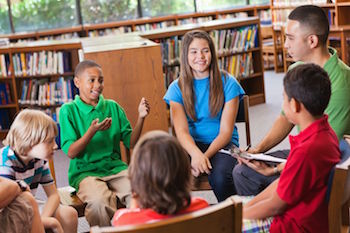Blog
Restorative Circles
Author: Kathleen Nelson-Simley
Posted: Friday - May 8, 2020
At some point, students will return to school, community-based programs and extra-curricular activities. When they do they will come with many questions, concerns and experiences on their minds and in their hearts. Giving your students the opportunity to tell their stories in an atmosphere of safety, trust, respect and equality will be vitally important.
Restorative practices can cultivate a culture of community in which all your students feel they belong and are seen, heard and respected – increasing the chances they will feel comfortable sharing their stories with you and each other.
Circles are the foundation of restorative practices. Restorative circles proactively build the trust students need to safely risk self-disclosure, authenticity, confrontation, empathy and care. Circles develop the relationships and skills students need to support one another and collectively address the challenges they face.
Circles are exactly what they are called. Students are arranged in a circle shape so that everyone can see every face without having to lean forward.
Sitting in a circle is a fundamentally different experience than sitting in rows or meeting across a desk. When we are in rows there is generally someone standing in front who is commanding our attention. Clearly, this is the person who is in charge and who has the answers and to whom the group is accountable to. When we are meeting with someone who faces us from behind a desk we instinctively know the authority and power belongs to that person.
When we sit in a circle we experience a stronger sense of community. Every person in the circle shares responsibility for its functioning. There is a “leader” in the circle, but each person still takes the lead each time it is their turn to speak.

You can use restorative circles for a wide variety of purposes, such as relationship development, conflict resolution, healing, support, decision making and information exchange. Depending on your intentions, restorative circles can take shape in two primary ways:
1. Proactive Circle
Proactive circles are preventative in nature and are about giving students the opportunity to get to know each other and establish positive connections, including agreements about how they should treat each other. Proactive circles include community building activities that are facilitated – giving each person the opportunity to speak uninterrupted and be heard by the other members of the group. Proactive circles provide an opportunity for building trust, authentic listening, empathy and conflict resolution skill building.
2. Responsive Circle
Responsive circles are typically utilized after proactive circles have been established and routinely used. Responsive circles address incidents that result in harm, conflict or a change in the community that needs to be addressed. This circle uses specific high-quality questions to explore the impact or effects resulting from a challenging circumstance or event and move toward making things right.
There’s tremendous power in using restorative circles to set things right when there is conflict or harm done. Restorative thinking is a significant shift from punishment-oriented thinking. Students who are invited into restorative dialogue are sometimes confused by the concept of “making things right.” It’s a new concept and approach for many of them. They are most accustomed to punishment being the default response to the question of, “What can we do to make things right?”
It is said that “children learn what they live.” When they learn that problem behavior demands a punishment-oriented response that is how they will live. Restorative practices invite a new and different way of responding to problems, conflicts and harm. Learning this new way is best done by kids personally living it through restorative circles.
Let me leave you with this final thought…You won’t be able to “restore” a community until you have first built it. The longer your students are physically separated from one another the more likely you will need to re-build your community when they are back together again. Creating a new environment for your students where they can safely share their experiences, challenges, feelings and thoughts about living in a pandemic world will be one of the first important tasks at hand for you. Restorative circles can help you not only build this kind of environment for your students, but also sustain it over time. Once you accomplish this, then be ready to listen to your students’ stories.
For more information about how you can use restorative practices and circles with your students, contact Kathleen Nelson-Simley at kathleen@knslearningsolutions.com.
P.S. Are you interested in watching a re-play of the “Bringing Restorative Practices to Your Students” webinar that was live on May 7? No worries! You can watch the webinar re-play HERE!



